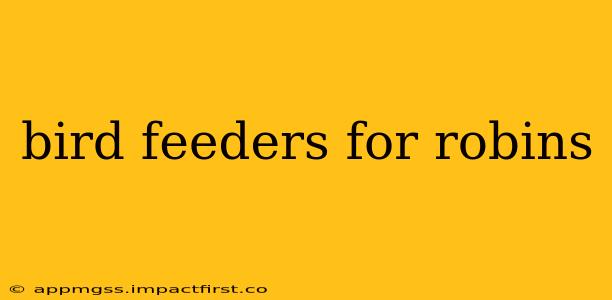Robins, with their cheerful songs and vibrant red breasts, are a welcome sight in any backyard. While these ground-foraging birds aren't typically drawn to traditional hanging feeders, there are ways to attract them and provide supplementary nutrition, especially during harsh weather or nesting season. This guide will explore effective bird feeders and feeding strategies for attracting robins to your garden.
What Kind of Food Do Robins Eat?
Robins are omnivorous, meaning their diet consists of both plant and animal matter. While they're known for their love of earthworms, they also consume a wide variety of insects, berries, seeds, and fruits. Understanding their diverse diet is key to choosing the right feeder and food.
What Type of Bird Feeder is Best for Robins?
Unlike many songbirds that readily visit hanging feeders, robins prefer to forage on the ground. Therefore, the most effective "feeder" for robins is less a feeder and more a strategically placed food source. Consider these options:
- Ground feeders: These are shallow, wide dishes placed directly on the ground. They provide easy access for ground-feeding birds like robins. However, they're also more susceptible to contamination from other animals.
- Platform feeders: Similar to ground feeders, platform feeders are elevated slightly off the ground, providing some protection from larger predators while still offering easy access for robins.
- Suet feeders: While not their primary food source, suet cakes can offer extra calories during colder months. Choose suet feeders with a wide base or those that allow for placement on a low post.
What Food Should I Put in a Robin Feeder?
Offering a varied diet is crucial for attracting and maintaining a healthy robin population. Consider these options:
- Mealworms: A high-protein food source that is particularly appealing to robins, especially during breeding season. You can purchase dried or live mealworms.
- Berries: Fresh or dried berries such as raspberries, blueberries, and cranberries provide essential nutrients. You can place these directly on the ground or in a shallow dish.
- Chopped fruit: Pieces of apple, banana, or grapes can be attractive to robins. Avoid overly ripe or spoiled fruit.
- Suet: While not a staple, suet offers high energy content during colder months.
Do Robins Use Traditional Hanging Feeders?
While not their preferred method of feeding, robins may occasionally visit hanging feeders containing fruit or berries. However, don't expect them to rely solely on hanging feeders for their nutritional needs. A combination of ground-based food sources and potentially a low hanging feeder with fruit will maximize your chances of attracting them.
How Can I Attract Robins to My Yard Besides Feeders?
Providing a welcoming habitat is just as important as offering food. Consider these steps:
- Provide water: A birdbath or shallow dish of water is essential for drinking and bathing.
- Plant native shrubs and trees: These provide natural food sources and shelter.
- Create a safe environment: Minimize the use of pesticides and herbicides, and provide ample cover from predators.
What is the Best Time of Year to Put Out Food for Robins?
While robins can be seen year-round in many areas, supplemental feeding is particularly beneficial during harsh weather conditions (like cold snaps or snowstorms), during breeding season (spring and early summer), and when natural food sources are scarce.
By understanding the dietary preferences and habits of robins, and by employing a combination of appropriate feeders and food sources, you can significantly increase your chances of attracting these delightful birds to your backyard. Remember that creating a safe and welcoming habitat is crucial for their long-term presence and well-being.
